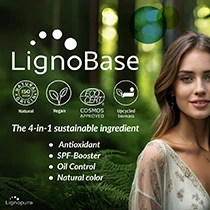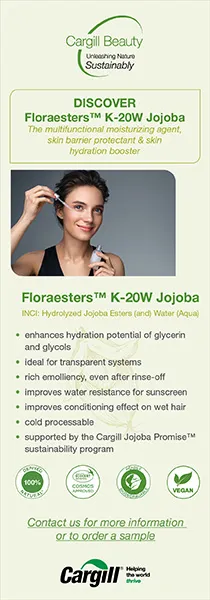PFAS fallout: UK cosmetics industry contradicts allegations of unsafe “forever chemicals” in makeup
16 Jan 2023 --- The UK-based Cosmetic Toiletry & Perfumery Association (CTPA) is sharing science-based facts about the controversial use of per- and polyfluoroalkyl substances (PFAS) – or “forever chemicals” – in cosmetics. In light of a recent BBC report warning that these chemicals pose a serious health risk from makeup, it emphasizes that PFAS used in makeup does not make products unsafe as they undergo strict regulation to meet legal safety requirements.
“In the very rare cases where PFAS are used in cosmetics, the products have been carefully reviewed and approved by a qualified safety assessor to confirm that they pose no risk to our health,” CTPA’s scientific team tells PersonalCareInsights.
“PFAS ingredients are very rarely used in cosmetics, and cosmetic scientists are working hard to develop new innovative alternatives for the very small number of those still in use to offer people the same product benefits they value.”
PFAS are substances of over 4,500 individual chemicals with various properties and do not easily degrade in nature.
“Critically, this doesn’t change the fundamental fact that every cosmetic and personal care product and their ingredients – including PFAS – must be safe. This is a strict legal requirement,” stresses CTPA.
Glaring pollution levels
On the other hand, PersonalCareInsights speaks to Dr. Julie Schneider, PFAS campaigner at CHEM Trust, who is in favor of a total ban on PFAS. Meredith says that less than 2% of CTPA member companies reported using PFAS ingredients in 2020.
Meredith says that less than 2% of CTPA member companies reported using PFAS ingredients in 2020.
“Considering the scale of the PFAS pollution crisis and the known impacts of PFAS exposure to human health and the environment, the continued use of PFAS where they are not absolutely necessary, such as cosmetics, is not acceptable,” she states.
“CHEM Trust together with 35 UK organizations has been calling on the UK government to urgently ban all unnecessary uses of all forever chemicals [by 2025].” The joint NGO Statement flags that PFAS pollution has caused an “irreversible toxic legacy of global contamination” and is “fuelling the biodiversity crisis.”
Moreover, these chemicals are accumulating inside bodies and its pollution is a threat to UK drinking water.
Why PFAS?
CTPA explains that in the cases where PFAS are used in the industry, they are included to make cosmetics easier to apply or more water resistant. Water and oil-resistant properties create long-lasting skincare and makeup products, which can also give hair fibers a smooth, high-gloss finish and frizz protection.
Pharmacist Dr. Emma Meredith, director-general at CTPA, shared a video message on social media to “reassure the safety of our cosmetics and personal care products that we love and use every day.”
“You may have seen recent media coverage about using a group of substances known as PFAS in cosmetics,” she said.
“Less than 2% of CTPA member companies reported using PFAS ingredients when surveyed in 2020. Three years on, this figure is even lower because companies have been further phasing out PFAS. Cosmetic scientists have developed innovative alternatives that offer people the same product benefits they value.”
The association shares that in the case of the nine PFAS chemicals that are used within cosmetics, it is “confident” that they are subject to the same “extremely strict” UK and EU safety laws.PFAS are used to make cosmetics easier to apply or more water resistant.
Furthermore, the UK cosmetics industry has been working with the government on PFAS for the past three years as it develops an action plan for the chemicals in the UK. The UK cosmetics industry has been sharing information with the government about the minimal use of PFAS in the cosmetics sector and how companies are moving to alternatives.
Deciphering the labels
As consumers pay more attention to what goes in their products, there is a need for personal care companies to embrace full transparency. “Regarding identifying the presence of PFAS, all cosmetics and personal care products in the UK will display a full ingredients list,” shares CTPA.
“Although PFAS chemicals will contain the word ‘fluoro’ in the name because they contain fluorine, looking for the word ‘fluoro’ is not a reliable indicator because fluoride ions and fluoride-containing minerals, for example, in toothpaste and makeup, also contain the word ‘fluoro.’”
“These substances are not PFAS because they have a completely different chemistry – a bit like the difference between olive oil and diamonds,” it adds.
However, if consumers require more information on ingredients used in their cosmetic and personal care products, then CTPA recommends they contact the manufacturer.
On how PFAS can be detected in products, Schneider says that total organic fluorine analysis or TOF is an efficient analytical method, as it has been shown for food packaging.
 ECHA plans to publish the proposal on February 7.“It is not expected to have interference from the presence of other organofluorine chemicals in consumer products, unlike in environmental samples, and therefore a TOF content is a good proxy for a total PFAS content,” she suggests.
ECHA plans to publish the proposal on February 7.“It is not expected to have interference from the presence of other organofluorine chemicals in consumer products, unlike in environmental samples, and therefore a TOF content is a good proxy for a total PFAS content,” she suggests.
Last October, a study warned that certain levels of 13C4-Perfluorooctanoic acid – a kind of PFAS – can be absorbed internally via the skin when mixed into a sunscreen.
Update on the EU side
In related news, the EU Chemicals Agency (ECHA) reported on January 13 that Denmark, Germany, the Netherlands, Norway and Sweden submitted a proposal to ECHA to restrict PFAS under REACH, the EU chemicals regulation.
ECHA plans to publish the proposal on February 7. The proposal came after the five member states found risks in the manufacture, market placement and use of PFAS, which are “not adequately controlled and need to be addressed throughout the EU and the European Economic Area.”
However, the proposal concerns the use of PFAS in general – over a wide range of industries.
CTPA concludes that the cosmetics industry welcomes scientific investigations into PFAS chemicals as laws must be based on the latest science, are risk-based and proportionate.
By Venya Patel












